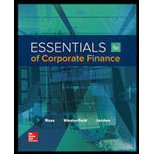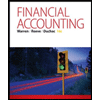
a)
To calculate: The shareholders’ equity for 2016 and 2015.
Introduction:
Cash flow refers to the difference between the cash that comes into the business and the cash that goes out of the business. The following are the different types of cash flows in a corporation:
- Cash flow from assets:
It refers to difference between the revenues from the sale of assets and the money invested in purchasing the assets.
- Cash flow to creditors:
It refers to the interest paid to the creditors minus the net fresh debt borrowed by the company.
- Cash flow to stockholders:
It refers to the dividend paid to the shareholders of the company minus the fresh equity raised by the company.
- Operating cash flow:
It refers to the cash flow from operating activities of the firm.
a)
Answer to Problem 22QP
The stockholders’ equity for 2015 is $7,273. The stockholders’ equity for 2016 is $6,311.
Explanation of Solution
Given information:
The current assets are $2,718, the net fixed assets are $12,602, the current liabilities are $1,174, and the long-term debt is $6,873 for the year 2015. The current assets are $2,881, the net fixed assets are $13,175, the current liabilities are $1,726, and the long-term debt is $8,019 for the year 2016.
Formulae:
Compute the total assets for 2015:
Hence, the total assets for 2015 is $15,320.
Compute the total liabilities for 2015:
Hence, the total liabilities for 2015 is $8,047.
Compute the stockholders’ equity for 2015:
Hence, the stockholders’ equity for 2015 is $7,273.
Compute the total assets for 2016:
Hence, the total assets for 2016 is $16,056.
Compute the total liabilities for 2016:
Hence, the total liabilities for 2016 is $9,745.
Compute the stockholders’ equity for 2016:
Hence, the stockholders’ equity for 2016 is $6,311.
b)
To calculate: The change in net working capital for 2016.
Introduction:
Cash flow refers to the difference between the cash that comes into the business and the cash that goes out of the business. The following are the different types of cash flows in a corporation:
- Cash flow from assets:
It refers to difference between the revenues from the sale of assets and the money invested in purchasing the assets.
- Cash flow to creditors:
It refers to the interest paid to the creditors minus the net fresh debt borrowed by the company.
- Cash flow to stockholders:
It refers to the dividend paid to the shareholders of the company minus the fresh equity raised by the company.
- Operating cash flow:
It refers to the cash flow from operating activities of the firm.
b)
Answer to Problem 22QP
The change in net working capital for 2016 is ($389).
Explanation of Solution
Given information:
The current assets are $2,718 and the current liabilities are $1,174for the year 2015. The current assets are $2,881 and the current liabilities are $1,726 for the year 2016.
Formulae:
Compute the ending net working capital:
Hence, the ending net working capital is $1,155.
Compute the beginning net working capital:
Hence, the beginning net working capital is $1,544.
Compute the change in net working capital:
Hence, the change in net working capital is ($389).
c)
To calculate: The cash flow from assets for 2016, and the fixed assets sold in 2016.
Introduction:
Cash flow refers to the difference between the cash that comes into the business and the cash that goes out of the business. The following are the different types of cash flows in a corporation:
- Cash flow from assets:
It refers to difference between the revenues from the sale of assets and the money invested in purchasing the assets.
- Cash flow to creditors:
It refers to the interest paid to the creditors minus the net fresh debt borrowed by the company.
- Cash flow to stockholders:
It refers to the dividend paid to the shareholders of the company minus the fresh equity raised by the company.
- Operating cash flow:
It refers to the cash flow from operating activities of the firm.
c)
Answer to Problem 22QP
The cash flow from assets is $10,239. The company sold $3,153 worth of fixed assets.
Explanation of Solution
Given information:
The company had sales of $40,664. The costs of goods sold were $20,393. The company charged $3,434 as
Formulae:
Compute the net income:
| Company P | ||
| Income statement | ||
| Particulars | Amount | Amount |
| Net sales | $40,664 | |
| Less: | ||
| Costs | $20,393 | |
| Depreciation | $3,434 | $23,827 |
| Earnings before interest and taxes | $16,837 | |
| Less: Interest paid | $938 | |
| Taxable income | $15,899 | |
| Less: Taxes ($15,899×40%) | $6,360 | |
| Net income | $9,539 | |
Hence, the net income is $9,539.
Compute the operating cash flow:
| Company Q | |
| Operating cash flow | |
| Particulars | Amount |
| Earnings before interest and taxes | $16,837 |
| Add: Depreciation | $3,434 |
| $20,271 | |
| Less: Taxes | $6,360 |
| Operating cash flow | $13,911 |
Hence, the operating cash flow is $13,911.
Compute the net capital spending:
| Company Q | |
| Net capital spending | |
| Particulars | Amount |
| Ending net fixed assets | $13,175 |
| Less: Beginning net fixed assets | $12,602 |
| $573 | |
| Add: Depreciation | $3,434 |
| Net capital spending | $4,007 |
Hence, the net capital spending is $4,007.
Compute the cash flow from assets:
The operating cash flow is $13,911. The change in net working capital is ($389), and the net capital spending is $4,007.
Hence, the cash flow from assets is $10,293.
Compute the fixed assets sold:
Hence, the value of fixed assets sold is $3,153.
d)
To calculate: The cash flow to creditors, and the amount of long-term debt paid off.
Introduction:
Cash flow refers to the difference between the cash that comes into the business and the cash that goes out of the business. The following are the different types of cash flows in a corporation:
- Cash flow from assets:
It refers to difference between the revenues from the sale of assets and the money invested in purchasing the assets.
- Cash flow to creditors:
It refers to the interest paid to the creditors minus the net fresh debt borrowed by the company.
- Cash flow to stockholders:
It refers to the dividend paid to the shareholders of the company minus the fresh equity raised by the company.
- Operating cash flow:
It refers to the cash flow from operating activities of the firm.
d)
Answer to Problem 22QP
The cash flow to creditors is ($208). The company paid off $1,009 worth of long-term debt.
Explanation of Solution
Given information:
The long-term debt is $6,873 for the year 2015, and the long-term debt is $8,019 for the year 2016. The raised $2,155 in new long-term debt. The company paid interest amounting to $938.
Formulae:
Compute the net new borrowing:
Hence, the net new borrowing is $1,146.
Compute the cash flow to creditors:
Hence, the cash flow to creditors is ($208).
Compute the debt paid off:
Hence, the value of debt paid off is $1,009.
Want to see more full solutions like this?
Chapter 2 Solutions
ESSENTIALS CORPORATE FINANCE + CNCT A.
- Your firm is considering an expansion of its operations into a nearby geographic area that the firm is currently not serving. This would require an up-front investment (startup cost) of $989,060.00, to be made immediately. Here are the forecasts that were prepared for this project, shown in the image. The long-term growth rate for cash flows after year 4 is expected to be 4.73%. The cost of capital appropriate for this project is 12.48%. What is the NPV, Profitability Index, IRR and payback in this case?arrow_forwardUse the binomial method to determine the value of an American Put option at time t = 0. The option expires at time t = T = 1/2 and has exercise price E = 55. The current value of the underlying is S(0) = 50 with the underlying paying continuous dividends at the rate D = 0.05. The interest rate is r = 0.3. Use a time step of St = 1/6. Consider the case of p = 1/2 and suppose the volatility is σ = 0.3. Perform all calculations using a minimum of 4 decimal places of accuracy. =arrow_forwardConsider a European chooser option with exercise price E₁ and expiry date T₁ where the relevant put and call options, which depend on the value of the same underlying asset S, have the same exercise price E2 and expiry date T₂. Determine, in terms of other elementary options, the value of the chooser option for the special case when T₁ = T2. Clearly define all notation that you use.arrow_forward
- The continuous conditional probability density function pc(S, t; S', t') for a risk neutral lognormal random walk is given by Pc(S, t; S', t') = 1 σS'√2π(t' - t) - (log(S/S) (ro²)(t − t)] exp 202 (t't) In the binomial method, the value of the underlying is Sm at time step môt and the value of the underlying at time step (m + 1)St is Sm+1. For this case evaluate Ec[(Sm+1)k|Sm] = [°° (S')*pc(S™, mdt; S', (m + 1)8t)dS' showing all steps, where k is a positive integer with k ≥ 1. You may assume that 1 e (x-n)2 2s2dx = 1 for all real numbers n and s with s > 0.arrow_forwardJohn and Jane Doe, a married couple filing jointly, have provided you with their financial information for the year, including details of federal income tax withheld. They need assistance in preparing their tax return. W-2 Income: John earns $150,000 with $35,000 withheld for federal income tax. Jane earns $85,000 with $15,500 withheld for federal income tax. Interest Income: They received $2500 in interest from a savings account, with no tax withheld. Child Tax Credit: They have two children under the age of 17. Mortgage Interest: Paid $28,000 in mortgage interest on their primary residence. Property Taxes: Paid $4,800 in property taxes on their primary residence. Charitable Donations: Donated $22,000 to qualifying charitable organizations. Other Deductions: They have no other deductions to claim. You will gather the appropriate information and complete the forms provided in Blackboard (1040, Schedule A, and Schedule B in preparation of their tax file.arrow_forwardOn the issue date, you bought a 20-year maturity, 5.85% semi-annual coupon bond. The bond then sold at YTM of 6.25%. Now, 5 years later, the similar bond sells at YTM of 5.25%. If you hold the bond now, what is your realized rate of return for the 5-year holding period?arrow_forward
- Bond Valuation with Semiannual Payments Renfro Rentals has issued bonds that have an 11% coupon rate, payable semiannually. The bonds mature in 17 years, have a face value of $1,000, and a yield to maturity of 9.5%. What is the price of the bonds? Round your answer to the nearest cent.arrow_forwardanalyze at least three financial banking products from both the liability side (like time deposits, fixed income, stocks, structure products, etc). You will need to examine aspects such as liquidity, risk, and profitability from a company and an individual point of view.arrow_forwardHow a does researcher ensure that consulting recommendations are data-driven? What does make it effective, and sustainable? Please help explain and give the example How does DMAC help researchers to improve their business processes? How to establish feedback loops for ongoing refinement. Please give the examplesarrow_forward
 Financial Accounting: The Impact on Decision Make...AccountingISBN:9781305654174Author:Gary A. Porter, Curtis L. NortonPublisher:Cengage Learning
Financial Accounting: The Impact on Decision Make...AccountingISBN:9781305654174Author:Gary A. Porter, Curtis L. NortonPublisher:Cengage Learning Financial AccountingAccountingISBN:9781305088436Author:Carl Warren, Jim Reeve, Jonathan DuchacPublisher:Cengage Learning
Financial AccountingAccountingISBN:9781305088436Author:Carl Warren, Jim Reeve, Jonathan DuchacPublisher:Cengage Learning

